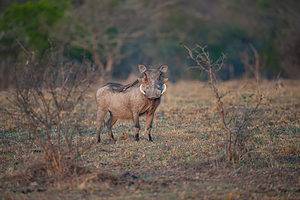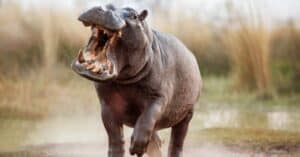Campbell Hill, Ohio’s highest point, boasts a vibrant ecosystem filled with flora and fauna. While Ohio may not exactly scream “wildlife haven,” Campbell Hill is definitely hiding a secret. From birds soaring above to critters trundling through the underbrush, the hill is home to many animals. Whether you’re a nature enthusiast or just looking for adventure, this hidden gem is worth discovering.
This article will dive into the 13 incredible animals that call Campbell Hill home. But first, let’s peek into Ohio’s thriving habitat system. With four distinct habitats, Ohio is a hotbed for wildlife. So get ready to explore Ohio’s wild side as we introduce you to Campbell Hill’s incredible animal diversity.
1. White-Tailed Deer
If you visit the highest point in Ohio, don’t be surprised to see white-tailed deer (Odocoileus virginianus) lurking around. These majestic creatures have lived in the region for thousands of years. They supplied Native people with necessities, including food, hides, and tools made of their bones and antlers.
While enjoying the stunning view atop Campbell Hill, keep your eyes peeled for these fascinating creatures. With their reddish-brown fur and signature white tail, they’re hard to miss.
And with an estimated population of 600,000 in Ohio alone, you’re likely to spot one or two. So keep your camera handy and your distance respectful, as we can all appreciate these living inhabitants of Ohio’s highest point.
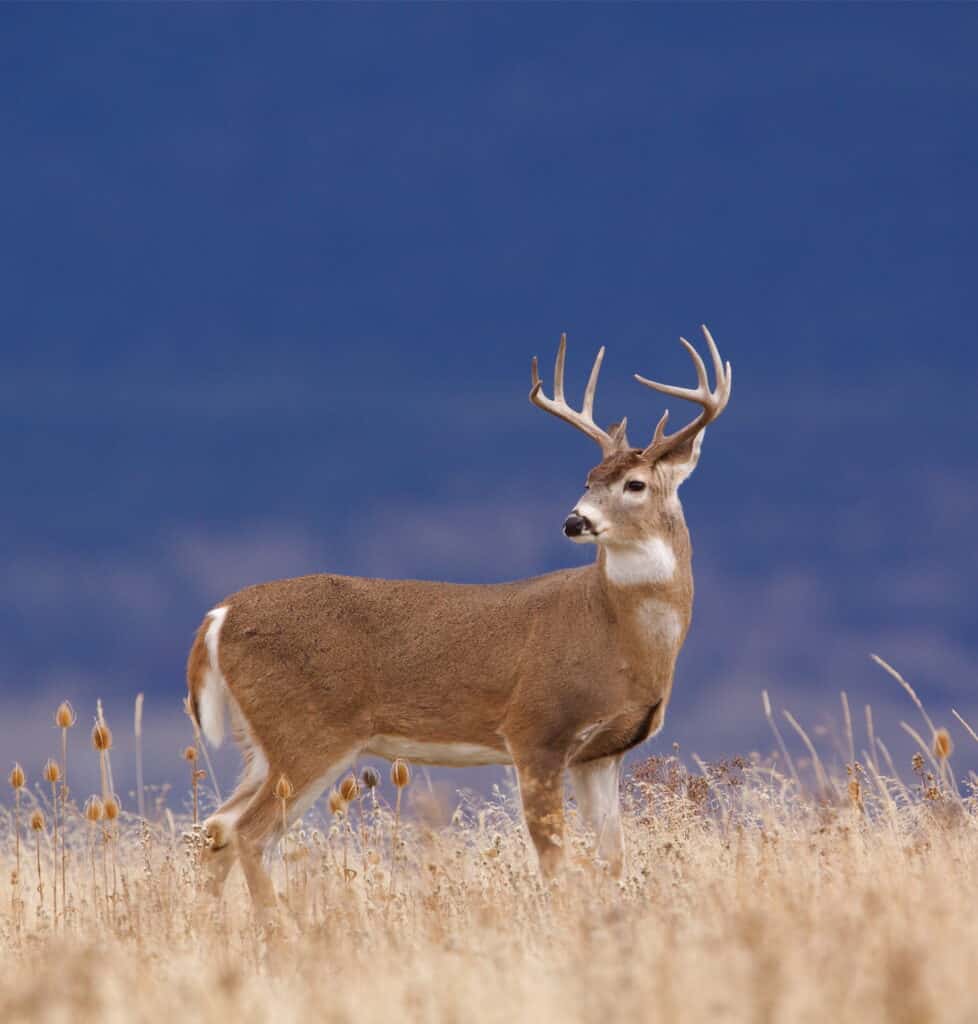
If you visit the highest point in Ohio, don’t be surprised to see white-tailed deer.
©Tom Reichner/Shutterstock.com
2. Black Racer Snake
You may want to watch for the black racer snake (Coluber constrictor) while wandering atop Campbell Hill, Ohio’s highest point. This slinky serpent is Ohio’s official reptile and can be spotted throughout the state.
Aside from being a common sight, the black racer plays a vital role in the ecosystem. It gobbles up rodents that cause chaos for farmers. While encountering any snake can be startling, there’s no need to fear the black racer since it’s not venomous.
If you see one while exploring Ohio’s picturesque landscapes, snap a photo or admire it from a safe distance. The black racer snake may not be the cuddliest creature, but it deserves recognition for its essential pest control services.
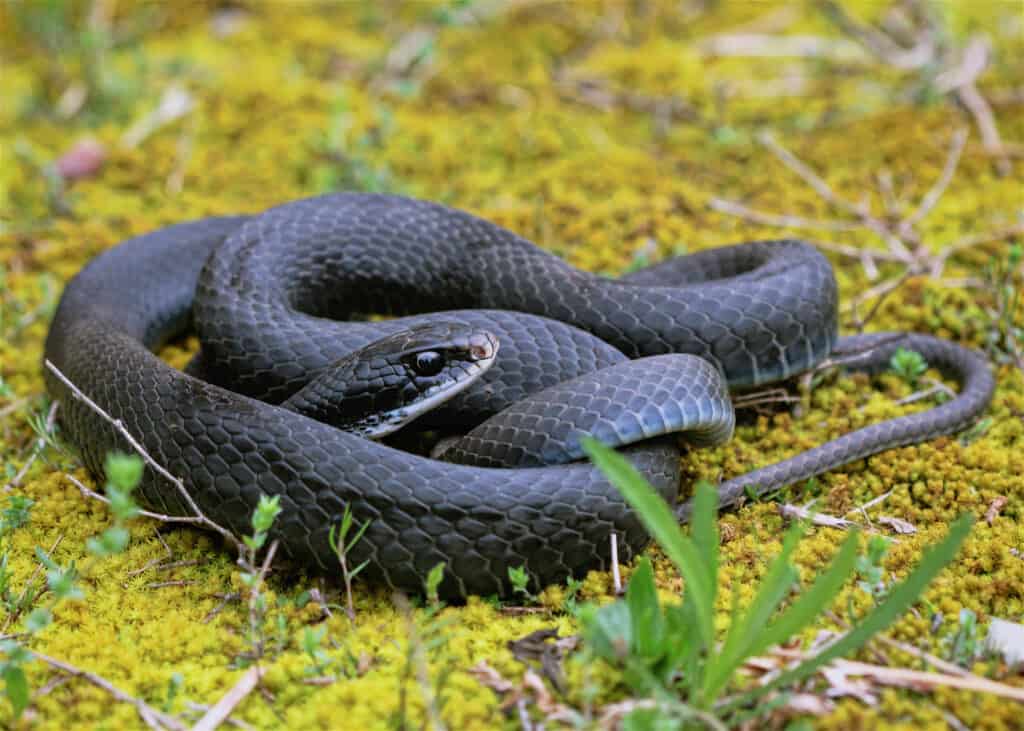
Reaching lengths of up to 6 feet, black racer snakes are non-venomous and rely on their speed to capture prey.
©Matthew L Niemiller/Shutterstock.com
3. Cardinal
One of the most incredible places to see a cardinal (Cardinalis cardinalis) is Campbell Hill. As Ohio’s highest point, this is where the bird reigns supreme over its territory. At 1,549 feet, Campbell Hill presents an excellent spot to enjoy Ohio’s natural beauty while spotting cardinals in their element.
Male cardinals are known for their red plumage and black face masks, and they’re often seen perched atop trees singing melodic tunes.
Females are more subtle with muted feathers but equally charming. Whether you’re a bird lover or just looking for a breathtaking view, a trip to Campbell Hill is a must-do; maybe you’ll see Ohio’s state bird there.
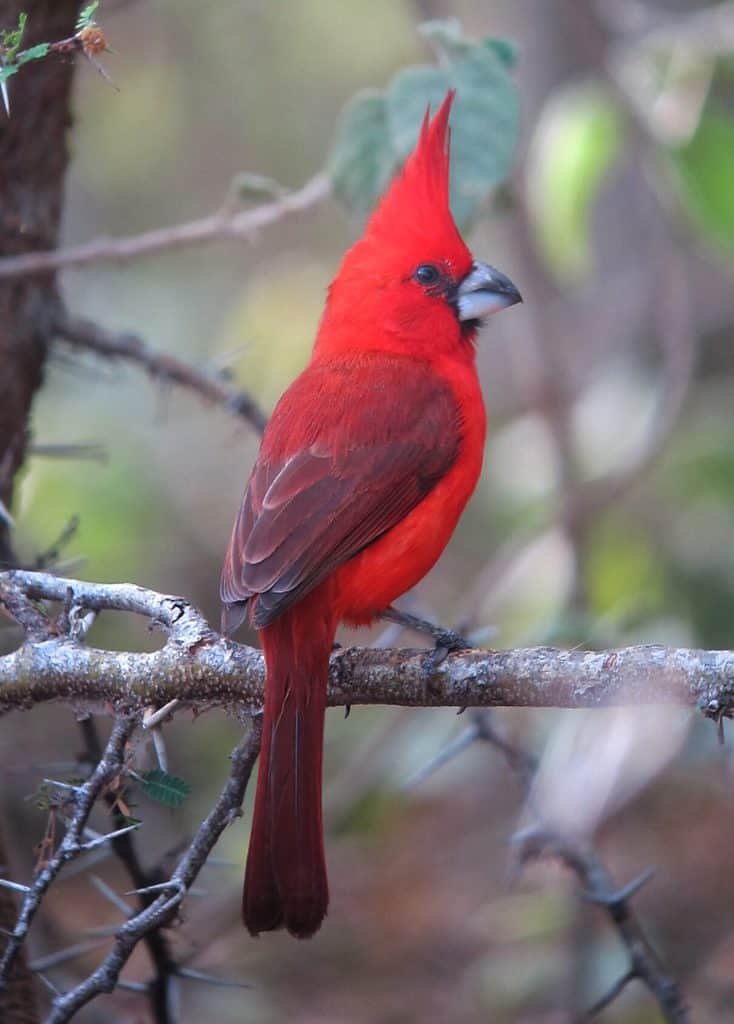
The northern cardinal (
Cardis cardinalis) is found across North America, from Canada to Mexico.
©Félix Uribe, CC BY-SA 2.0 – License
4. Spotted Salamander
Have you heard about the spotted salamander? It lurks atop Campbell Hill, Ohio’s highest peak, moving stealthily through underground tunnels and crevices at night.
Ohio’s low-lying woodlands offer the most suitable environment for these rotund creatures, usually found around creeks, swamps, and ponds. The spotted salamander has a distinct pattern of spots, from yellow to gold, which makes it a shared state animal by Ohio and South Carolina.
If you’re lucky enough to spot them, they offer a spectacular sight and are essential to Ohio’s diverse wildlife. Keep your eyes peeled and enjoy the thrill of seeing these elusive creatures in the wild.
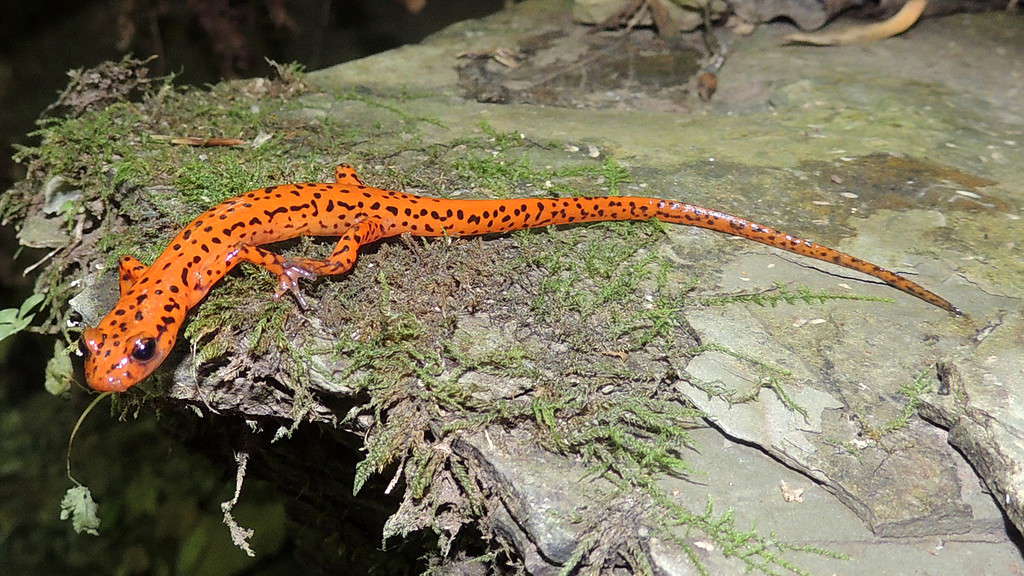
The spotted salamander (
Ambystoma maculatum) is a species of mole salamander native to the United States.
©Hargle on English Wikipedia, CC BY-SA 3.0, via Wikimedia Commons – License
5. Bullfrog
The bullfrog, Ohio’s official frog, lives in marshes, streams, and ponds. With its deep and surprisingly territorial croak that can be heard up to a mile away, the bullfrog has a reputation for being a boisterous amphibian.
The bullfrog is not just your average amphibian. It is the largest in the U.S. and has an impressive lifespan of up to nine years. Unfortunately, it is caught for its legs and considered a delicacy in upscale restaurants.
Otherwise, enjoy the bullfrog’s distinctive call during summer and marvel at its impressive size.
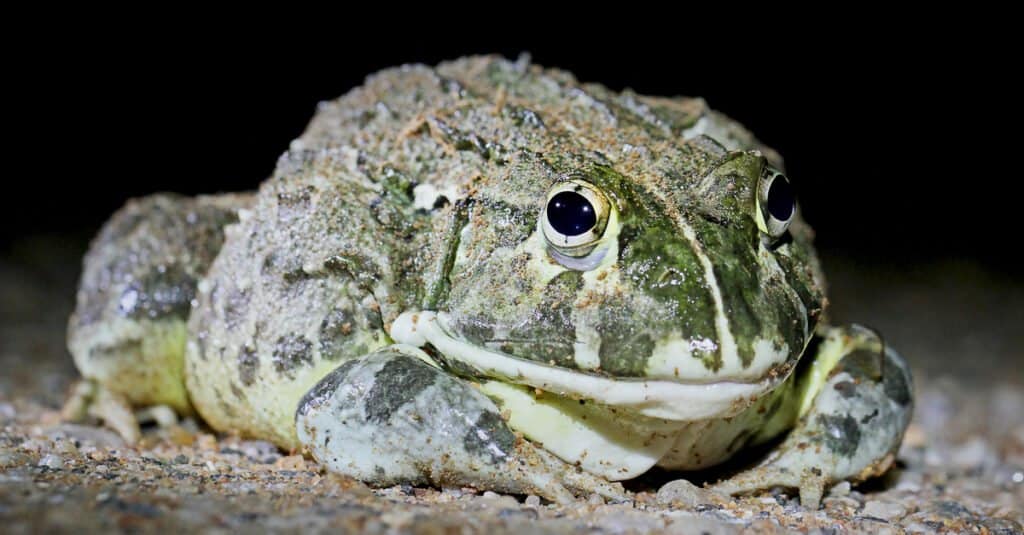
The American Bullfrog’s unmistakable call can be heard up to a mile away.
©Eugene Troskie/Shutterstock.com
6. Eastern Gray Squirrel
The eastern gray squirrel, otherwise known as the King of the Trees, rules Campbell Hill – Ohio’s Highest Point – with a mighty paw. These adorable furballs lurk everywhere, from the grand summit to the lowly forest floor.
With their fluffy gray coat and bushy tail, these squirrels look like they came straight out of a Disney movie. But don’t let their cuteness fool you – these critters are intelligent, resourceful, and always looking for their next snack.
You can spot these cute guys running around the hillside, scurrying up trees, or hanging out, soaking up the view. They move with such grace and agility. It’s like watching a ballet performance. The eastern gray squirrel is an integral part of Campbell Hill’s ecosystem, helping to disperse seeds and keep the forest healthy.
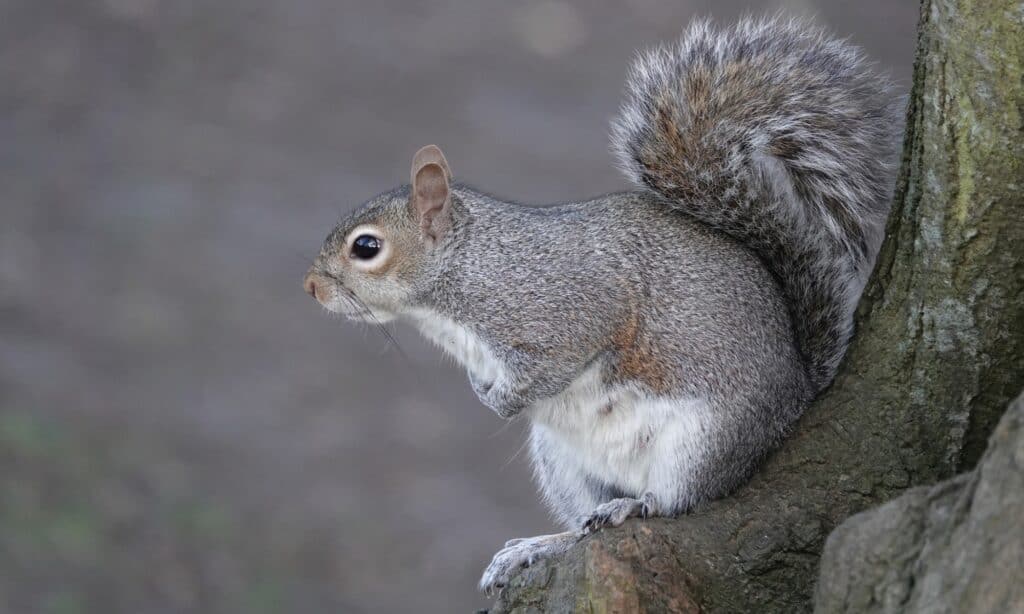
The eastern gray squirrel is a native species in North America and is one of the most common squirrels found in urban areas.
©iStock.com/Nigel Harris
7. Raccoon
With their trademark ringed tail, raccoons (Procyon lotor) have become quite comfortable in this lofty environment. Despite being seen as a nuisance by many people, raccoons are fascinating creatures. They possess incredible dexterity and problem-solving skills, using their nimble and curious paws to open doors, latches, and garbage cans.
And while they may be nocturnal, their distinctive chirps, growls, and snuffles can often be heard during the day as they root for food and make their mark on the landscape.
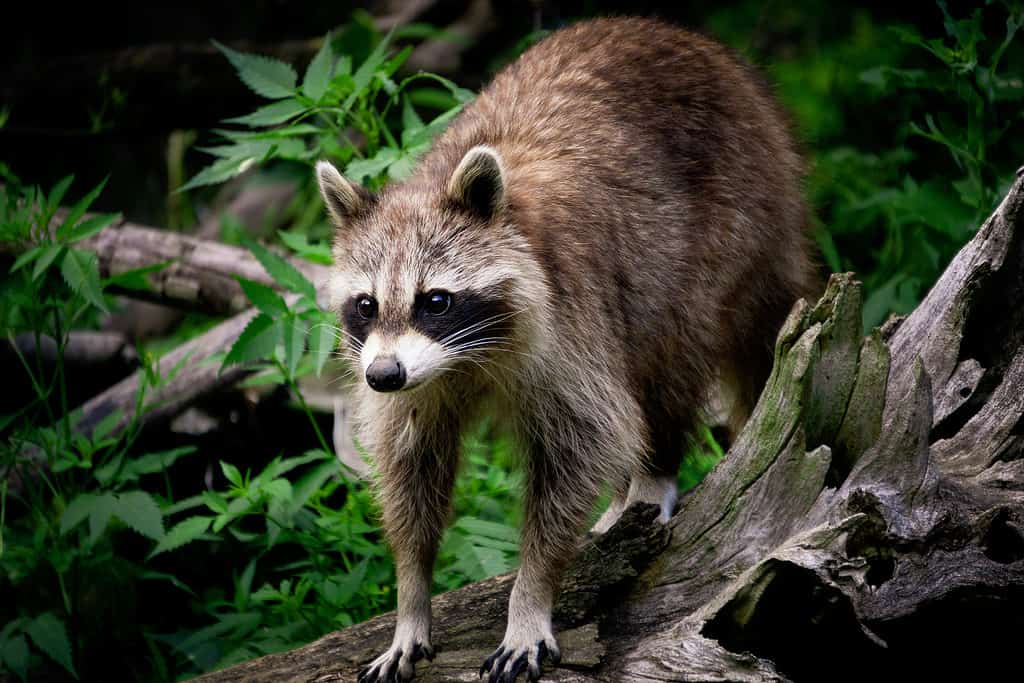
Raccoons possess incredible dexterity and problem-solving skills.
©John Wherley/Shutterstock.com
8. American Crow
Perched high atop Campbell Hill, Ohio’s highest point, the American crow (Corvus brachyrhynchos) sits as the regal king of the hill. With its jet-black feathers and sharp eyesight, this corvid bird is prevalent in the Midwestern state.
The American crow is a highly adaptable bird known for its intelligence and resourcefulness. While it can be found in rural and urban settings, it often scavenges for food or builds its nest out of sticks and twigs.
Despite its occasional tendency to raid crops or gardens, the American crow remains a beloved member of Ohio’s wildlife community.
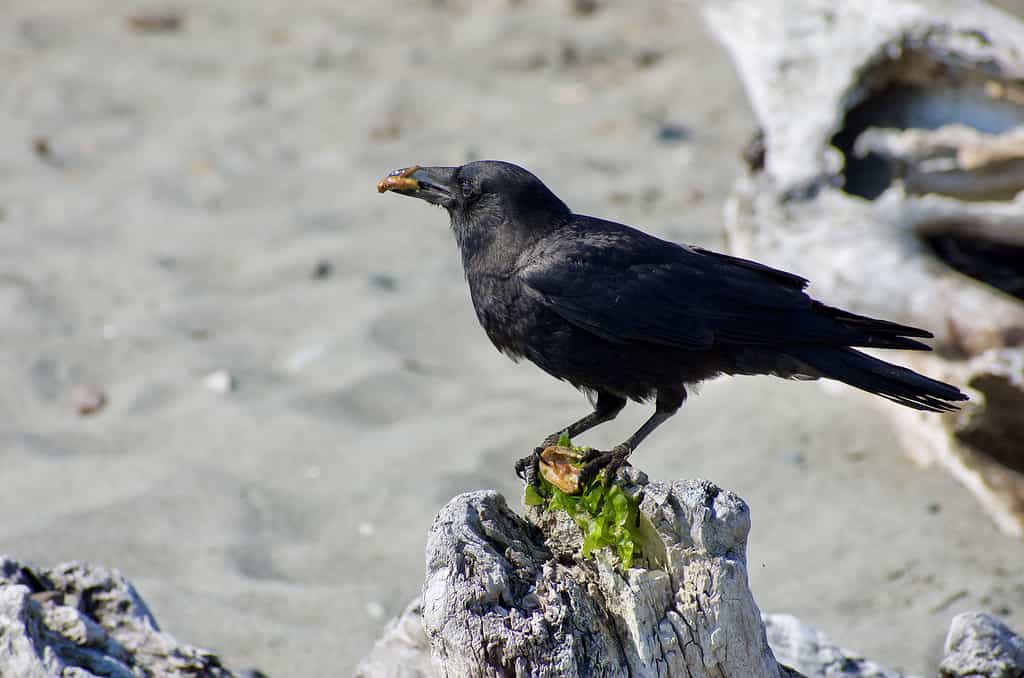
This American Crow is enjoying a hearty meal! Its black feathers and distinctive croaking call make it a common sight in North America.
©iStock.com/DanielLacy
9. Karner Blue Butterfly
The Karner blue butterfly (Lycaeides melissa samuelis) is rare and beautiful. It lurks atop Campbell Hill. But unfortunately, they are under threat.
Human activities such as land conversion for agriculture, urbanization, and pollution affect the Karner blue butterfly. As their habitat gets destroyed or degraded, their numbers decline, putting them at risk of extinction.
But what makes the Karner blue butterfly so unique? Firstly, they are tiny, measuring less than an inch in length. They also have distinctive blue wings with small orange spots at the edges.
Moreover, the Karner blue butterfly plays a crucial role in pollination, which is essential for plant survival. By helping to spread pollen, they maintain plant biodiversity and healthy ecosystems.
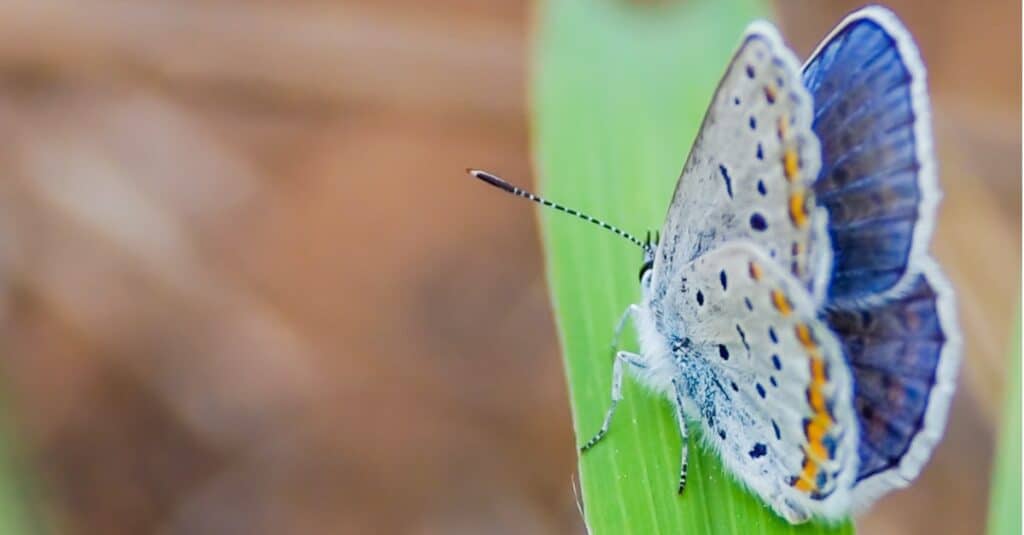
The Karner blue butterfly is an endangered species that can only be found in select locations in the United States.
©iStock.com/BobGrif
10. Eastern Box Turtle
Meet the eastern box turtle, (Terrapene carolina carolina) a creature of the forest and resident atop Campbell Hill – Ohio’s highest point. These reptiles, known for their striking shell design and striking coloration, have existed for 60 million years. They’ve stuck around so long that they’ve earned the nickname “living fossils.”
Don’t be fooled by their slow pace – eastern box turtles can move up to three football fields in a year. When not strolling through the woods, these turtles soak up the sun. They’re ectothermic, you see, meaning they need their environment to regulate their body temperature.
Don’t disturb the little guy if you spot a box turtle basking in the sun. It’s theirs until they move to a different spot. Plus, they’ll retreat into their shell if they feel threatened – and nobody wants to be responsible for sending a turtle back into a shell.
Although eastern box turtles may seem familiar, they’re rare. They can live for up to 100 years, but habitat loss, car strikes, and the illegal pet trade threaten their survival. If you see one of these fantastic critters while hiking Campbell Hill, remember to give them space. Enjoy observing them from afar.
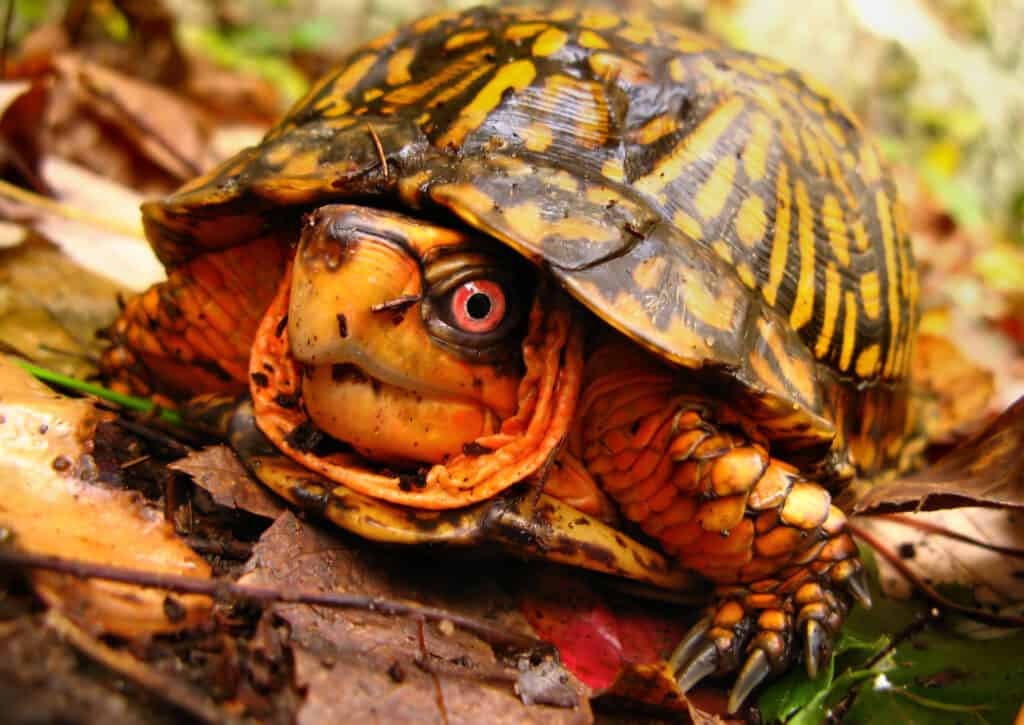
Eastern box turtles are known for their striking shell design and striking coloration.
©outdoorsports44/Shutterstock.com
11. Mourning Dove
Measuring roughly 12 inches long and sporting a 17-inch wingspan, these grayish-brown birds are iconic sights in Ohio. They have plump bodies, pointed wings, and a long, tapering tail. Their pink feet and black bill are other distinguishing features.
These feathered friends are familiar across North America and famous for their beautiful call, often heard in the early morning. Interestingly, their name doesn’t come from their somber-sounding coo but from their mourning-like behavior during the breeding season.
Mourning doves can be found in various habitats, including woodlands, cities, and suburbs. They are ground feeders and dine on seeds, fruits, and insects. Plus, they mate for life and are incredibly devoted partners.
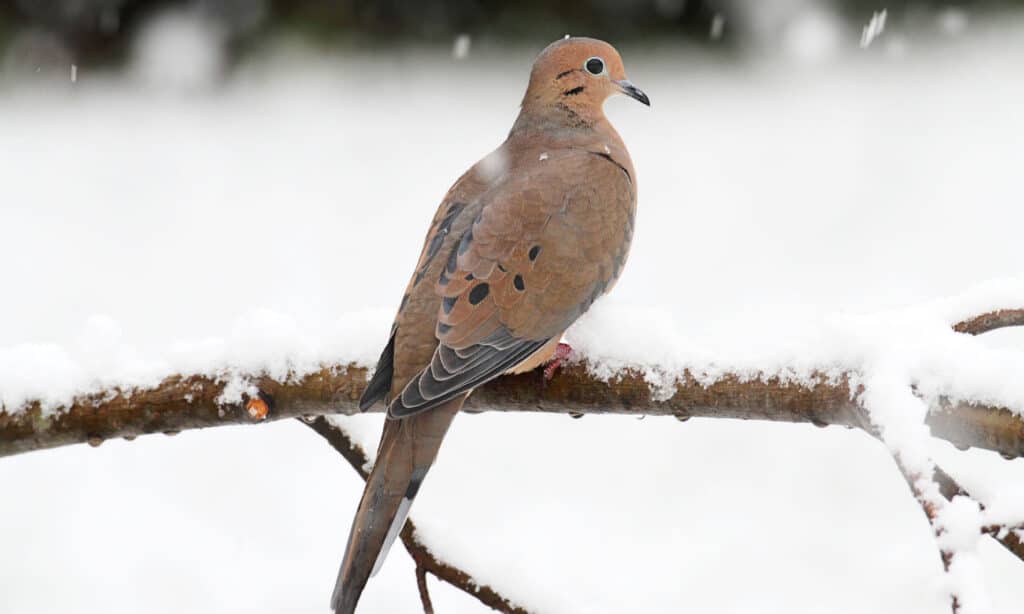
Mourning doves are common in Ohio, and known for their beautiful call, often heard in the early morning.
©iStock.com/SteveByland
12. Northern Long-eared Bat
The northern long-eared bat may be difficult to spot, but it’s worth watching. These nocturnal bats can be seen swooping through the sky at dawn and dusk.
These bats are small, about the size of a thumb. They prefer coniferous forests for roosting sites but can also be found in deciduous woodlands. When it comes to food, these bats are relentless. They feast on insects, including mosquitoes and moths, and are crucial to maintaining insect populations.
In Ohio, these bats emerge from their hibernation between April and June. Unfortunately, their populations have declined due to White-nose Syndrome. This disease has affected many bat species and devastated their populations.
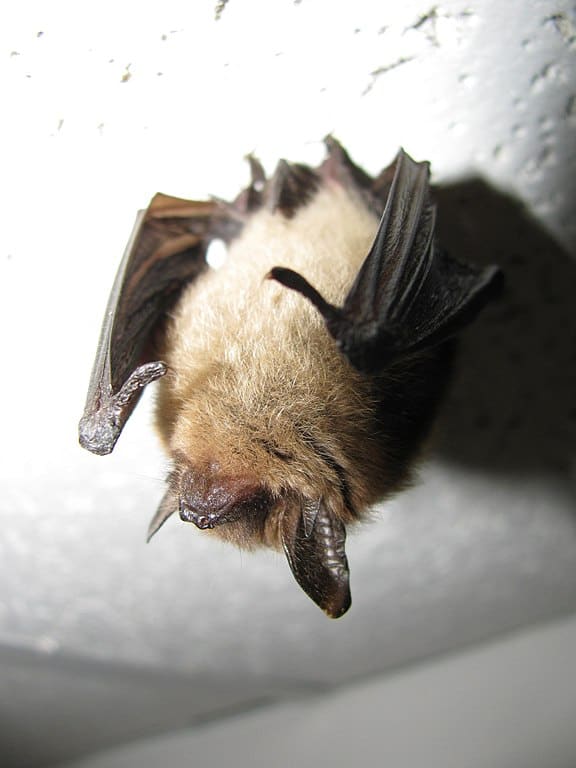
The northern long-eared bat (
Myotis septentrionalis) is only about the size of a thumb.
©Jomegat / CC BY-SA 3.0 – License
13. Henslow’s Sparrows
These cute feathered birds prefer grassland habitats with short vegetation, making them suitable for locating food such as insects, spiders, and seeds.
If you want to see these rare birds in action, you must visit during their breeding season, which runs from mid-May to late July. During this time, you can hear them singing their unique song while searching for mates and nesting sites among tall grasses or wetlands.
But don’t get too close, as Henslow’s sparrows are a protected species due to their declining population. Keep a safe distance and admire them from afar.
Campbell Hill is the perfect spot to observe these unique birds, so grab a pair of binoculars and head out for an adventure. You might even see other wildlife along the way.
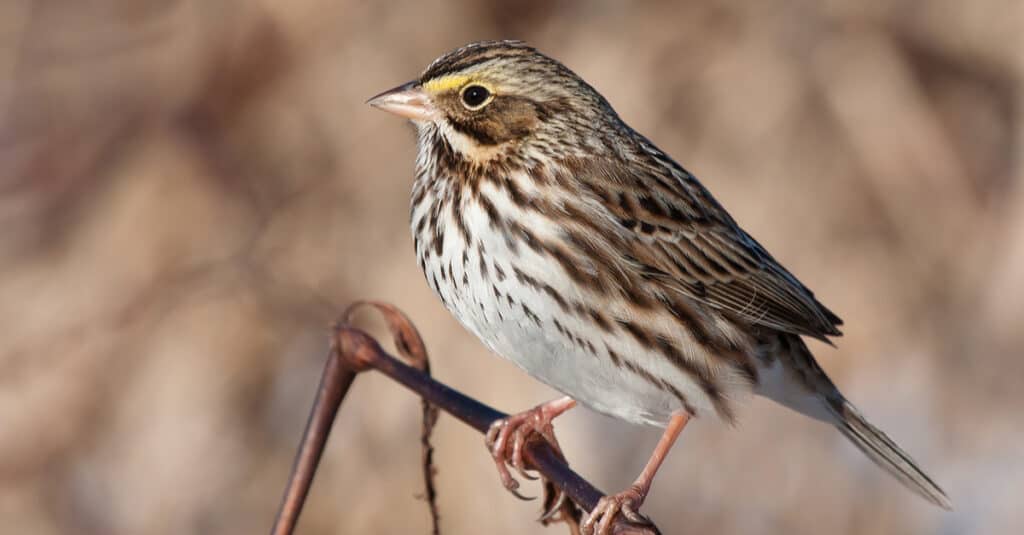
The Henslow’s sparrow is known for its distinctive, high-pitched ‘tseep’ call.
©Frode Jacobsen/Shutterstock.com
What You Can Do To Help Protect These Animals
Campbell Hill’s animals face several threats that endanger their survival, and as conscious beings, we can play our part in protecting them. Here are some things you can do to help:
- Keep your distance: If you’re lucky enough to spot these animals on your hike, it’s essential to maintain a safe distance. Wild animals are unpredictable, and getting too close to them can cause dangerous situations for you and them.
- Stick to designated trails: Campbell Hill animals need space to thrive. By sticking to designated trails, you avoid encroaching on their territory, minimizing disturbance.
- Do not feed them: While it might seem like a kind gesture to feed animals, it can harm their health. Human food is unsuitable for wild animals and can have long-lasting effects on their diets and health.
- Avoid flash photography: Flash photography can startle and disturb animals, impairing their senses and behavior. Respecting their habitat and avoiding flash photography when taking pictures is essential.
- Clean up after yourself: Leave the areas you visit as you found them or even better. Litter and waste can endanger animals if they eat or get entangled. Dispose of trash in designated bins and avoid leaving items behind.
Tips For Planning Your Visit To Campbell Hill
Looking to plan a trip to Ohio’s highest peak, Campbell Hill? Here are five detailed tips to ensure your visit succeeds:
1. When to Visit Campbell Hill
An ideal time to visit Campbell Hill is late spring through early fall. During these months, the weather is mild, with temperatures typically ranging from 60 to 80 degrees Fahrenheit. Exploring at this time of year provides fantastic views and enjoyment. However, before your trip, check the weather forecast and be prepared for sudden changes.
2. What to Bring to Campbell Hill
Ensure you’re adequately equipped for your Campbell Hill visit. Wear comfortable shoes or hiking boots, necessary for the terrain. Bringing sunscreen, water bottles, and snacks can make your stay better. Additionally, check local weather forecasts and pack accordingly.
3. How to Get to Campbell Hill
Getting to Campbell Hill is relatively simple, with routes provided by many transportation services. With large signs pointing, you can quickly find the park. The easiest way to visit Campbell Hill is by car; however, if you’re not from the area, it’s essential to identify the appropriately organized tour, making getting to and from the park accessible and stress-free.
4. What to Expect When You Visit Campbell Hill
Once you arrive at Campbell Hill, you’re greeted with an unbelievable view across the Ohio plains. While you explore the area, there are many activities you can engage in, such as hiking, bird-watching, picnicking, and more. Look out for local wildlife, like deer and birds, that make the park their home.
5. Rules and Regulations to Maintain Campbell Hill’s Natural Beauty
The park has some rules for visitors. Follow the instructions posted on the park’s informative signs. For instance, stay only in marked locations, and pack everything you bring. Respect local wildlife and nature by refraining from noisy activities, disturbing wildlife, and littering.
Visit Campbell Hill Today
Various animals call Campbell Hill home, from the majestic peregrines to the resourceful raccoons. Although it’s Ohio’s highest point, Campbell Hill stands at an average elevation compared to other states. Nevertheless, it is still worth visiting for its beautiful vistas, scenic hiking trails, and many fun activities for nature lovers.
With these distinct animal species hidden in its wilderness, Campbell Hill is not your typical mountain summit. It provides an excellent opportunity for butterfly research, wildlife observations, and more. So next time you plan your mountain adventure, drop by the magnificent Campbell Hill and explore the fascinating wildlife lingering atop Ohio’s highest point.
Summary Of 13 Animals Lurking Atop Campbell Hill
| Rank | Animal |
|---|---|
| 1 | White-Tailed Deer |
| 2 | Black Racer Snake |
| 3 | Cardinal |
| 4 | Spotted Salamander |
| 5 | Bullfrog |
| 6 | Eastern Gray Squirrel |
| 7 | Raccoon |
| 8 | American Crow |
| 9 | Karner Blue Butterfly |
| 10 | Eastern Box Turtle |
| 11 | Mourning Dove |
| 12 | Northern Long-eared Bat |
| 13 | Henslow’s Sparrows |
The photo featured at the top of this post is © iStock.com/Wirestock
Thank you for reading! Have some feedback for us? Contact the AZ Animals editorial team.



